
The Numbered Pens
Some of these pens are in small families. Where the same basic pen was made with plated or gold nib different model numbers were used, such as 44 and 49 for one family of pens. Additionally pens with a given model number changed considerably over time.
Nos. 44 and 49......................................download here
Nos. 45 - 50...........................................download here
Nos. 47 and 51......................................download here
No. 54 and relatives.............................download here
No. 55....................................................download here
No. 56 and Boots Chatsworth.............download here
Plain No. 59...........................................download here
No. 60....................................................download here
No. 61 and the B59s.............................download here
No. 65....................................................download here
Numbered era but no number!............download here
The 44 and 49 lineage
The basic dimensions of this group. Pre-war pens aren’t common, barrel lengths 72, 73mm., capped c. 114mm. Later pens also 72-3mm barrel length, capped 108-110mm. Cap threads are approximately 3/8 in. O.D. and the gold nibs are about 5mm wide at the shoulder. Steel nibs stainless (early) or plated.
Pictures 1-9 were done much earlier and A and B are latecomers from Akiva Gordon.
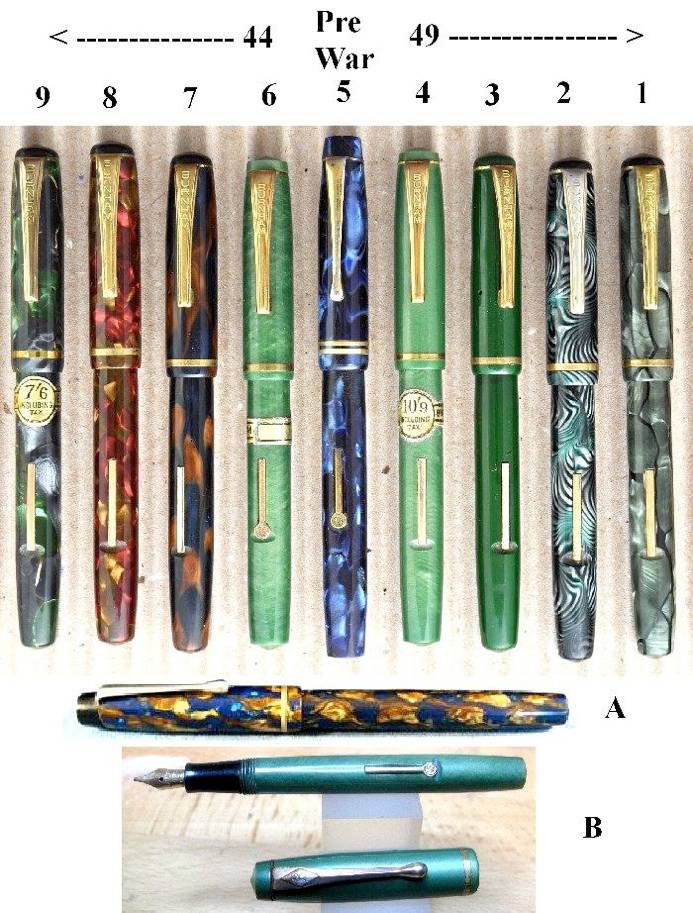
Pre-war pens were casein-bodied and tended to shrink so cap bands are loose. The fancier ones (5) had a matching coloured tassie and 2 cap bands, gold nib; more lowly ones (A) a black tassie and one cap band. They had plain teardrop clips and no barrel imprint, the only identification was on the nib. The lever was a rather trim small lollipop version.
A 1937 Coronation version of the single band pen was made - a cheap model with a stainless nib and chrome cap band. Somehow I think there would be a gold-nib version as well but I haven’t seen one.
The equivalents of these small pens don’t seem to have emerged immediately after the end of hostilities. They are not listed in Boots lists of 1949 and Steve Hull records the numbers 44 and 49 first in 1954. The two models are shown in an advertising leaflet from 1951 at the latest (ascribed to ca. 1954 - the leaflet is probably earlier than that as it shows the model 50 with a domed tassie and that had been supplanted by a flatter version by 1951).
The earliest versions of 44 and 49 had outlines shared with a number of pens of the period - barrel end and tassie finished with a sharply-defined coned outline (4, 6). They all had the vertically-lettered washer clip - except for one recorded case of a No. 49 (B) with the B-diamond clip. In the leaflet the 44 is shown with the small lollipop lever and the 49 with a plain straight lever. The pen in (B) is probably the earliest we have since it has the earlier pattern clip, and it also differs from the leaflet’s pens in having the combination of gold nid and lollipop lever. I’d guess 1948 for this pen.
In 1954 the 44 with steel nib cost 5/6d and the 49 with gold nib was 8/7d. We have some priced examples with coned outlines but they must be considerably later - they are priced at 6/11/2d and 10/9d respectively. By 1960 Boots had them priced at 7/- and 10/6d and thereafter their prices were reduced. The last recorded price tag for the 44 was 7/6d on some NOS pens..
There was little subsequent change in the style of these pens. The earliest have plain feeds, later ones have ladder feeds. The later pens mostly have variations on the common Burnham marbled casein (1,2, 9), earlier ones varied more, including flame pattern, solid, and pearlescent colours 3, 4, 6). The gold nibs have standard Burnham imprints. Nibs imprinted S20 are the last steel version, prior to that imprints vary. Many of these pens turn up without barrel imprints and these seem mostly to be pens which were sold in pen and pencil sets. The sharp conical outlines were lost at some uncertain stage in the 1950s (1-3, 7-9), and push-in sections supplanted by screw-in following this. The last stage in development of these pens saw the introduction of injection-moulded sections with a different and recognisable outline, and those for the model 44 were sold complete with ink sac as interchangeable units somewhat after the manner of the 1930's Sheaffer Addipoint.
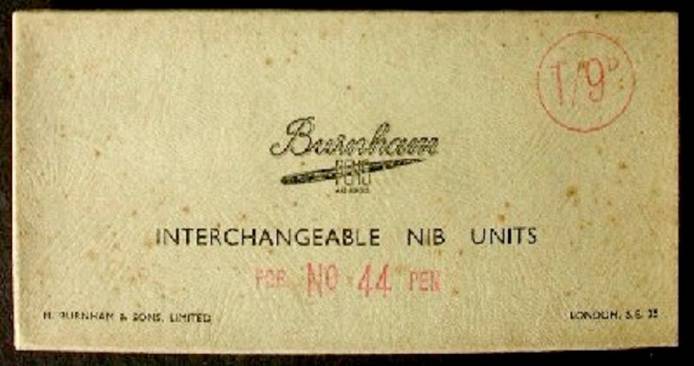
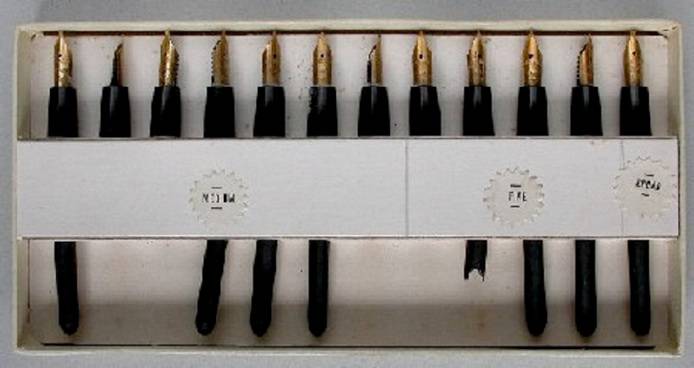
Pens as supplied
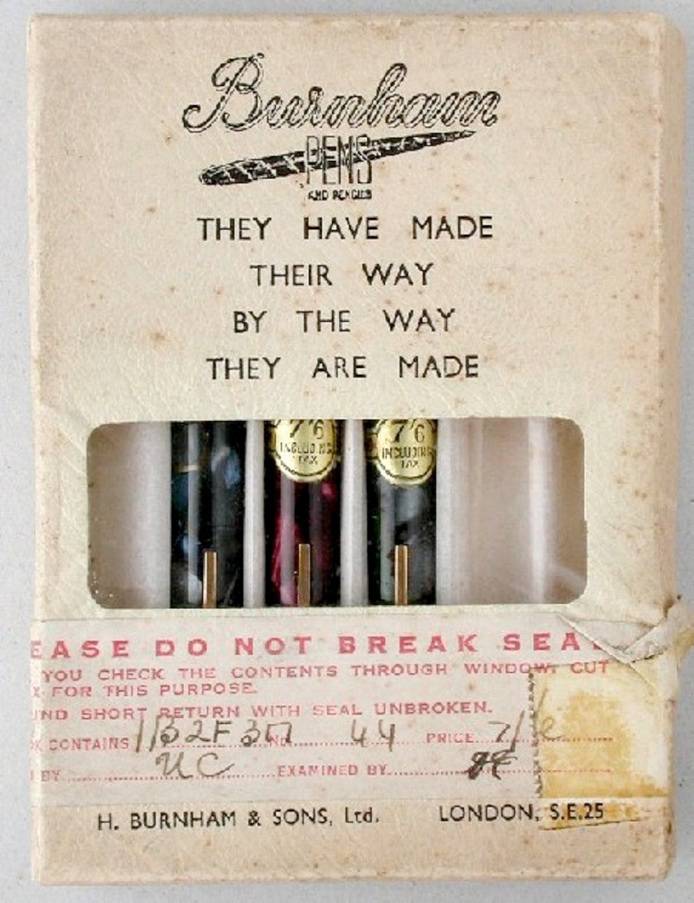
The 45, 46, 48 and 50 lineage
The basic dimensions of this group. Manufacturing tolerances in the pre-war period must have been quite generous because the barrel length varies from 80- 84mm. Later pens range from 82-85mm barrel length and this settles finally to a consistent 82-83mm. Capped they range from a minimum of 122mm. in forms with a tassie to 128mm. in forms with a cowled clip. Cap threads are approximately 7/16 in. O.D. and the gold nibs (most pens) are generally about 5.5mm wide at the shoulder. Almost all single cap band.
There is a good sequence of pre-WW2 pens which starts with a very common chunky mostly cylindrical model, lever or button-filler, with chromed single cap band (and lever if l/f) and either a stainless or a small gold nib (BD1). The lever is a lollipop with the gothic B imprint in a double circle. There were also occasional glass-nib stylos (BD glass nib) which came in a box labelled Crystal (picture of box below main one here). They are all imprinted The Burnham and have a squat curvaceous section and a plain teardrop clip. These pens could be called “mock baby duofolds” particularly the button-filler version. The material is (?always) casein. The earliest dated specimen we have is 1935, although the model likely goes back further than this. Some were made as Coronation specials for 1937 with fancy imprint and red white and blue tassie (Akiva Gordon photo below). The button-fillers had screwed sections and the lever-fillers plain push-in sections, a situation common in pre-war Burnhams.
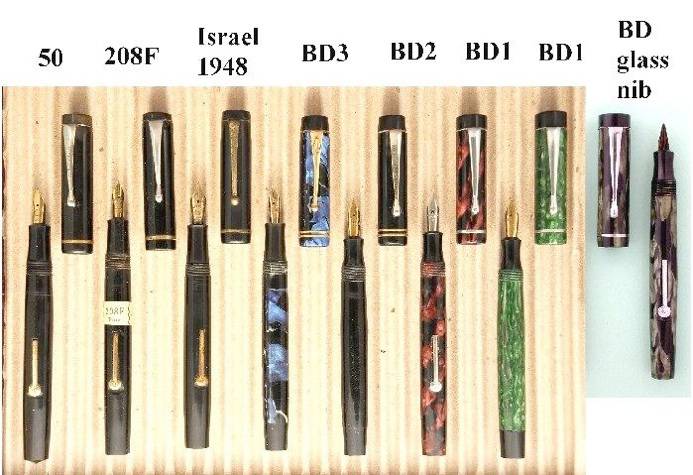

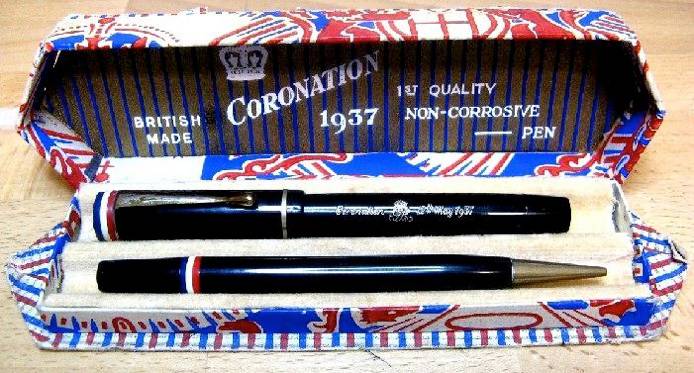
These pens seem to have mutated by two steps into a more streamlined form with two cap bands and some taper to the upper part of the cap. Tassie and barrel ends were quite flat. The squat section was lost in favour of one familiar in almost all Burnhams from the later 1930's onwards, and the occasional “mixed” pen (BD2) suggests the section shape changed after the body shape. The last pre-war generation of this pen (BD3) was quite smart as it had acquired also the teardrop clip with a B in a diamond-shaped facet. The general features of these pens appear in an advertisement dated 1939 though this exact model isn’t shown.

The nearest equivalent pen in the period emerging from WW2 is a model numbered 208F (208F, 208F gold) which is a plain pen with one cap band, and slightly domed or low conical ends to tassie and barrel. This form could be given the date 1948 - as it has been found with the Israel tax sticker that started in 1948 (Israel 1948 pic). However pens could be earlier, pre-war possibly, as the Israel sticker could have been applied to pens already in stock at the establishment of the state. So far only pens with a gold nib and gold plated lever and cap band have been positively identified to this model number. But we have a very similar one with a stainless nib, and chrome lever and band (208F? steel) and it has low conical cap and barrel ends. So far these are only represented by black pens and they have a distinct ‘austerity’ feel - the single cap band is part of this. All the postwar pens in this lineage seem to be lever-fillers. Lollipop levers are common in the early post-war years and many have a sunburst pattern on the lollipop - which is not identical to the Onoto sunburst! Others have a gothic B within a circle, normally a single circle in these post-war pens. The chrome lever on some post-war pens (e.g. no. 45) looks like a left-over from pre-war stock, with a double circle, but Bs are normally enclosed in a single circle in post-war pens.
The model 50 must represent initially a re-numbering exercise as we have a pen bearing No.50 with low conical ends (50 in top pic) which is essentially identical to the 208F with gold nib. The price of the 208F was 9/2d, and the model 50 was the same price in 1949 (and in 1954 the price of a model 50 was 9/- !) so there is price equivalence too (inflation, remember, was virtually non-existent in the period). It’s probable there was an equivalent to the 208F with a stainless nib but an identified specimen hasn’t been found yet - but we do have a pen that fills the bill. Judging by the relative frequency of specimens this stage didn’t last long relative to the next one.
The lineage definitely split into the gold nib and the steel nib branches with the next change in shape, in which the pens acquired a rounded barrel end and domed tassie. The model 50 kept gold-plated trim and gold nib (middle 2 50s, lower group), and the model 45 appeared with stainless nib, and chrome plated trim. The 50 mostly had a teardrop B-diamond clip and the 45 a plain teardrop (45, 50, lower group). These rounded pens were quite attractive, available in solid coloured and flame-pattern plastic. The 50s in solid colour usually had a self- colour tassie and occasional clipless specimens look as though they were deliberately finished that way. The 45s aren’t often found with the original nibs and it looks as though owners liked the pens enough to upgrade the nib. Up to this point now all the pens have push-in sections. There was also a glass nib version No. 46 (lower group). In 1954 the 45 and 46 cost 5/6d.
Next the pens lost the rounded barrel ends in favour of a conical form with rounded edges and summit, and the domed tassie was replaced by a similar softened low conical one. This change happened by 1951 as there was a Festival of Britain model 50 in this shape (below). The 50's with this shape normally have a vertically-lettered BURNHAM clip and this also is found on some 45s, others still have plain teardrop clips. In our rather limited sample all these pens have screwed sections except for one 45 with a plain teardrop clip. Pens with the new outline also generally had plain levers instead of the previous lollipop versions but some lollipops have been seen. It seems too that the 45 got an upgrade to gold plating on the trim!


(Barry Rose photos)
The introduction of interchangeable nib units and injection-moulded sections came with the introduction of the model 48 (correctly B48) about 1955-6. Section that accommodate the screw-in nib units are always recognisable as they have a rather heavier profile than the ordinary sections – compare these sections in the blue 50 and the prototype pen (below) with the ordinary section of the Festival of Britain pen (above). The 48 seems to have supplanted the 45 (and the 46 too, as we have a 48 with a glass nib in a normal hard rubber section). It seems the first 48's retained the smoothed conical ends in common with the 50, but the vast majority of 48's have a different cap and clip (lower group). They have a cap with more marked taper and a cowled clip held on by a screwed-in jewel. Some 50's were made with this cap too. While 48s are very common, 50s with the cowled clip are very rare - and even the previous low-tassie form of 50 is not that common. I don’t have prices for the 50 around this time. The 48 cost 7/6 at introduction although Boots began to reduce their price after 1960, and by 1962 it was only 6/6.
The nibs fitted to the screw-in units were plated steel and much more substantial than the previous versions of steel nibs. They are imprinted e.g. BURNHAM B48 FINE ENGLAND but mysteriously some, particularly italic ones, are imprinted B45 instead of B48. Is this a vestigial feature left over from the long-gone model 45?
Technically the 48 was supplanted by the acrylic pens with screw-in nib units (also priced at 7/6d), and these used the same units, though with a clunky moulded feed in later models. It is probable the two co-existed in sales outlets even if only the later form was actually being made. The 50 on the other hand seems to have vanished well before the last days of Burnham. Occasional specimens numbered 50 but with interchangeable plated nibs (below) have appeared in eBay and perhaps indicate that the 50 was subsumed into the 48.

The 48 was also used as a pattern for prototype acrylic-bodied pens (below) which apparently were hand-made by John Burnham in an effort to develop more attractive acrylic pens.


The 47 and 51 lineage
The basic dimensions of this group. Pre-war pens not identified (yet?). Barrel lengths 77-79 mm. Capped about 116-117mm.Cap threads are approximately 13/32in. O.D. and the gold nibs of the 51s are about 5.5mm wide at the shoulder (in fact I think they’re the same nib as the 50). Steel nibs of 47s are stainless (early) or plated S20. Usually single cap band, rarely two bands.
The earliest 51 seems to be that shown in the advertising leaflet, with conical barrel and cap ends, a 2-band cap, and a plain feed (1). Straight lever. A similar pen with a single cap band (2) is nearer to the appearance of later pens. The next stage of 51 (3) has low rounded conical ends, and ladder feed. The pens then acquired the cowled clip, at first with conventional section (4) and then with moulded acrylic section (5).
All the 47's so far have the same barrel profile, with low rounded conical end. The 47 probably started much later than the 51 as it is not present in the illustrated leaflet ca. 1951 but is present in the 1954 price list. What may be the oldest (9, far left) has a flat-top tassie and stainless nib. It is otherwise identical to the next- oldest (6) which has the low tassie. Pen (7) has an S20 plated nib in a conventional section, and a low tassie. Pen (8) has a cowled clip, and a moulded section with an interchangeable nib unit carrying an S20 nib. Presumably there was a stage with cowled clip and conventional section, corresponding to that version of the 51.
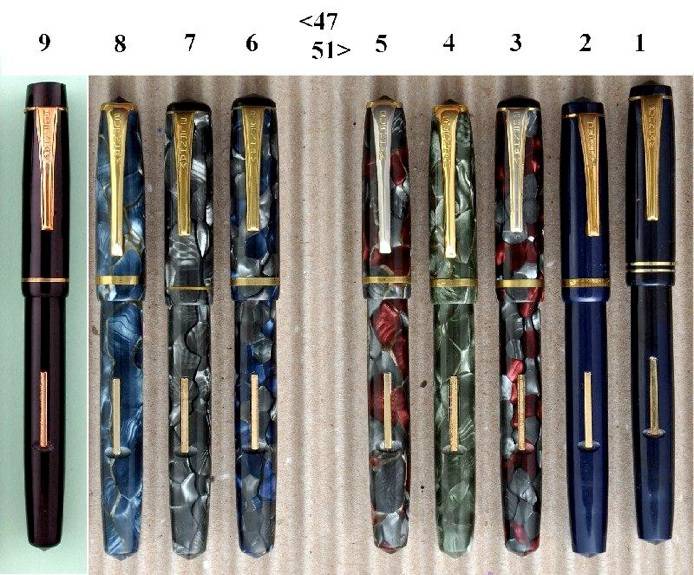
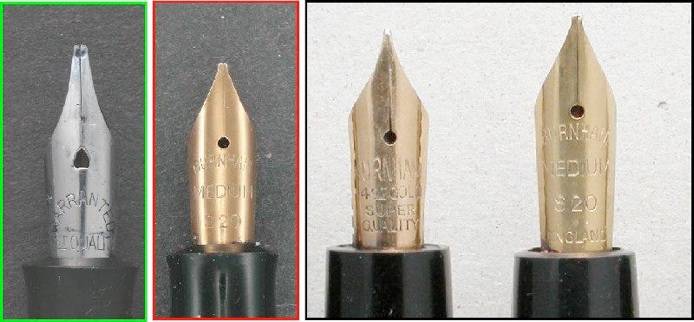
No. 47 stainless nib (oldest) and S20 plated nib in conventional sections, then No. 51 gold nib and No. 47 interchangeable S20 plated nib in moulded sections. Pics at different scales.
Dates and prices. The 47 was 5/6d and the 51 at 8/7d in 1954, rising to 7/- and 10/6d by 1960. The 47 in the low tassie form was issued as a special for the Coronation in 1953.
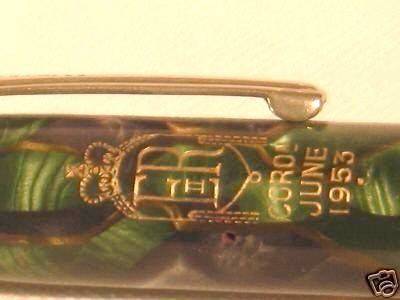
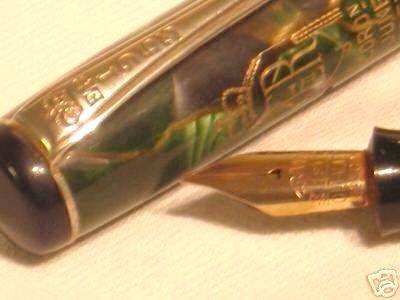
The 51 appears in pen and pencil sets in the cowled-clip form, below, imprinted for the Royal Yacht Britannia. That was launched in 1954 and the sets probably celebrated the occasion, thus dating the cowled clip to 1954. Certainly it is doubtful that the sets were made to be presented to visiting dignitaries - imagine the Queen presenting a medium grade Burnham writing set to the President of the USA, for instance! Quality control was not good either, as I have a nice mint Britannia pen and pencil set in box – and the pen illustrated here has black veining in its green and greythe pencil has amber veining.

At the end of Burnham’s life they introduced a pen numbered 51, with a very small gold nib, in the acrylic range.
The 54 lineage
There are two parts to this lineage. There is a later part which runs from the later 1930's through the postwar years, which hangs together dimensionally although there is a jump from the 30's to the post war period. There is an earlier part which connects back to older pens more by general features of design and function. Cap bands 1 or 2 depending on period.
The basic dimensions of the main (later) part of this group. Barrel length 77-79 mm. Capped 116-120mm.Cap threads are approximately 3/8in. O.D. and caps and barrels from different parts of the era will normally fit together. The gold nibs are about 5.5mm wide at the shoulder (in fact I think they’re the same nib as the 50 and 51). Stainless steel nibs (pre- war) imprinted ‘non-corrosive’.
Starting in the middle, then, with the later 1930's. There are long slim marbled pens (1) in the flat-top style of the 1939 advertisement, which came as pen/pencil sets in boxes labelled Burnham 1st Quality Non-Corrosive Pen – with a stainless nib. These have no imprint except on the nib, they have a single cap band, a plain teardrop clip, and a small lollipop lever with a gothic B. I would have taken these to be ladies pens but in fact the boxed set I have belonged to a Bernard Brashell. This pen was around at least from 1937 as there is a Coronation version of it (un-numbered, below main picture and caption) with patriotic red white and blue tassie.
No. 54 and relatives - caption on next page.

No. 54 and relatives - 1 non-corrosive late 1930's, small lollipop lever; 2 1948 12/10 pen domed, small lollipop lever; 3 domed metallic c.1952, small lollipop lever; 4 domed multicolour = 1930's material, small lever; 5 pen from 240 Minor set, small lollipop lever; 6 domed solid blue, plain lever; 7 domed marbled, plain lever; 8 screwed clip, maroon, small lollipop lever, imprinted 54; 9 screwed clip, swirl, plain lever, imprinted 54; 10 screwed clip, plum, plain lever, imprinted 54; 11 screwed clip, plain lever, moulded section, imprinted 54.

Coronation 1937
There seem to be no similar pens found as yet in the ‘economy’ era at the end of WW2, but a new ‘torpedo-shaped’ slender model was introduced in 1948 at 12/10d (2). This pen had a single cap band, a neat domed tassie and rounded barrel end. It has a clip not seen elsewhere on the fountain pens, but known on a pencil, with a flat diamond-shaped end and a rather fancy letter B up on the shoulder of the clip. It was available only in black. It had a small gold nib as described above, and the neat small lever with gothic B. It was imprinted The “Burnham” Pen, an unusual imprint which crops up occasionally elsewhere.
Now the story gets a little jumbled. Somehow the 12/10 special metamorphosed into the 54. There is a dome stage in the metamorphosis first (3-7). There is a range of pens with two cap bands, occasionally only one, and a clip vertically lettered BURNHAM. Otherwise these are the same size, same dome, same nib, various solid and marbled colours, a small lollipop or plain lever. They have generally no barrel imprint. But..... one has been recorded with the imprint MADE IN ENGLAND, and one has been seen in eBay with the imprint Burnham England No. 54.
That one still had a price sticker, 12/10d, so must be near in time to the 12/10 special. However, any other pens of this size have been priced lower, e.g. 10/6d, 10/8d or 10/9d. This seems odd if they are later production. One explanation might be that Burnham thought they could charge over the top for a new look model of pen, but were soon disillusioned. The jumble does not end there. In the 1954 price list there is a pen/pencil set No. 240 Minor at 18/-. And a set 254 at 19/3d. There is a pen no. 54 at 10/8d. The pen in Minor 240 is a black 2-band (5, and below) the same size etc. as the relatives, so it comes under the heading of a 54. The pen in set 254 is presumably a 54 too ? Why the difference? What does it mean?
Up to this point all the pens described have plain feeds and push-in sections. In the next stage the clip changed to the streamline form held on the top of the cap by a screw-in jewel. All (?) these pens are imprinted Burnham England No. 54. Some of these have ladder feeds and push-in sections, one even has a lollipop lever. Then there are some with ladder feed and screw-in hard rubber sections, and others with ladder feeds and moulded sections. At least in this subset there is an impression of successive stages of modernisation in small ways.


From the later 1930's on, then, there is a dimensionally consistent lineage leading to the No. 54. There are earlier pens of very similar dimensions that may have given rise to the lineage.
Although the dimensions of the pens do not tally exactly, there is a case to be made that the late 1930's “Non-Corrosive Pen” (12 on pic below) is related back to one of the early BP3 forms of pen. There is a pen of similar size from the TB period, though rather wider in the barrel (13), which commonly came with a ‘non-corrosive’ nib. There were also pens in coloured material imprinted Burnham’s Non-Corrosive Pen (14) which are the same dimensions as the early presumed hard rubber BP3s (15) that seem to have been made by Onoto/De La Rue. All these earlier pens share the same cap thread too, at a little bit over 3/8 in. O.D. just wide enough not to be interchangeable with the later pens.
Some more variations on the theme are shown below.
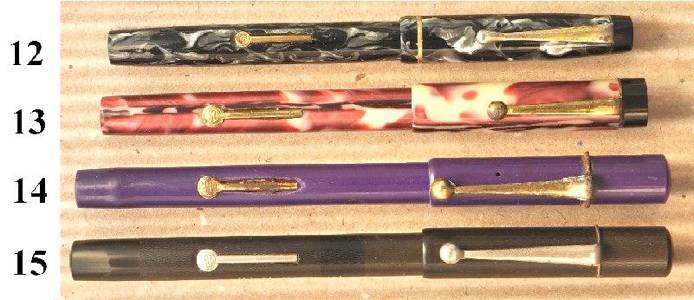

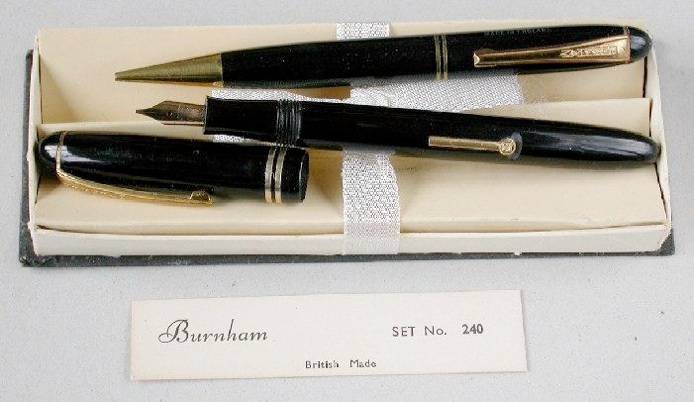
Set 240 (2 views)
More early 1950’s versions – in flame-pattern casein below, and on the next page one in multicolour casein stock which was probably left over from the 1930’s as it is also seen in a ringtop with the earlier clunky section.

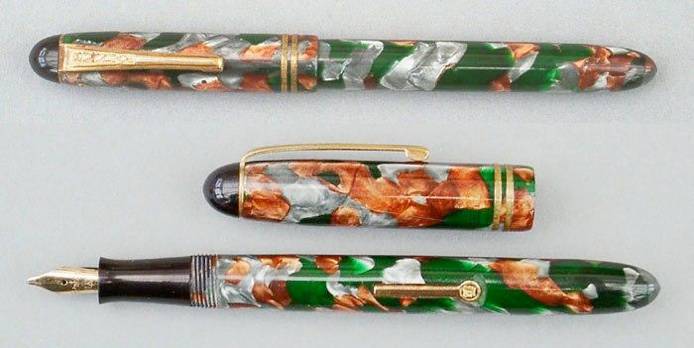
And finally – a pen with No. 54 imprint and 12/10 price.

The 55 lineage
The basic dimensions of this group. Barrel lengths 86-89mm (earlier), 82-83mm (later). Capped length 13-14 cm. Cap threads are approximately 7/16in. O.D. and the gold nibs are generally 6mm wide at the shoulder. Early no. 55 pens have plain feeds, later have ladder feeds. Single cap band (early postwar) or two bands (later postwar, and prewar equivalents)
The earliest part of this lineage is the confusing post-war model 232F, a plain lever-filling pen with coned ends, a plain teardrop clip, and with a single cap band. It is imprinted The Burnham. We have several specimens, only one with an identifying label but others have been seen in eBay. There are austerity specimens of absolutely appalling quality which fall apart as you look at them, and there are pristine glossy specimens too. These pens have a plain lever, a lollipop with a B and single ring motif, or a sunburst and ring motif. This model of pen also appeared in ebay imprinted Burnham No. 55, with a plain lever.
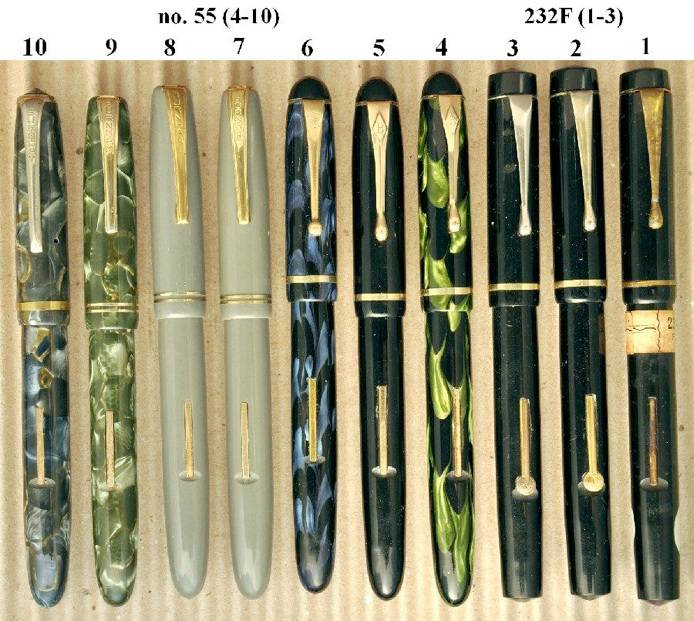
Pens in picture:
(1) Labelled 232F, Israel c.1948? plain lever; (2 ) presumed 232F, gothic B lever; (3) presumed 232F, sunburst lever; (4 ) green flame casein cf Conway c. 1952; (5 ) black casein; (6) blue flame casein cf Conway c. 1952, sunburst clip, shorter pen then 4&5; (7) grey casein - The "Burnham" Pen, no number; (8) grey casein - Burnham Pen London England, no number, different shade; (9) green marble casein, no number, ladder feed; (10) blue marble casein, 55 imprint, 48-style cap, ladder feed.

Ebay pic, pen imprinted no. 55, older form with cone-ended tassie and barrel.

Barry Rose pic, pen with flattened dome tassie.

Two Barry Rose pics,pens with glass nibs, one with jewel clip, one with cowled clip.
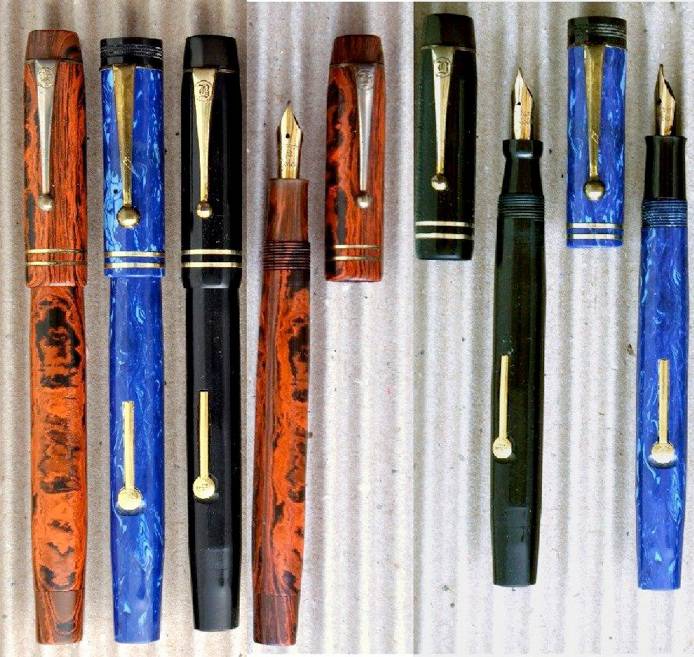
Following the pens including and resembling 232F there is the coned-tassie 55 and then a fairly frequent no. 55 with a nice rounded barrel end, and a tapered cap with a small domed tassie. These are lever-fillers with a 20.5 or 21.5mm plain lever. Many are in attractive flame-pattern plastic, or plain black. All have plain feeds. The usual clip is a B-diamond teardrop, a rarer form has BURNHAM lettered vertically, and a sunburst motif has also been found. That could be a replacement from an Onoto..... but I don’t think so, the rays seem to be different. This version must be 1951 at the latest, since the pre-Festival of Britain leaflet shows the jewel-clip version.
The specimen shown by Barry Rose with flattened dome tassie would come between the small-dome version of 4-6 and the jewel-clip version.
The rather elegant small domed 55 was replaced by a jewel-clip version quite early on, early 1950s I think, as this is shown in the same advertisement as the large-domed 59. All the jewel-clip 55s have a screw-in jewel so they must postdate the jewel-clip versions of 60 and 65. But they do go well back in time as the presumed earliest 55s in this form have plain feeds like their predecessors, while the later ones have ladder feeds. They all have the later short (18.5mm) lever. Barry Rose advertised at one stage a version of 55 with the low rounded tassie and this presumably is a short-lived variant between the small domed tassie and the jewel-clip version.
There is one mystery about the jewel-clip no. 55. Why did so many of them lack any identifying number, and are simply imprinted Burnham Pen London England? These are dimensionally exactly the same pen. It may have been like the situation in 44s and 49s where pens in sets often weren’t imprinted. Rarely they are imprinted The “Burnham” Pen Made in England, like the 12/10d pen in the no. 54 lineage and the mystery pens of the section “What model number are these?”; these are probably 1948 like the other similarly imprinted pens.
The jewel-clip 55 was briefly supplanted by a version with cowled clip, as happened to the no. 50. We have one pen with this kind of cap (10) and Barry Rose also produced one. The one in my possession has the same rounded barrel-end as most other 55s.
The no. 55 was priced at 12/10d by Boots in 1949, at 12/5 in the Burnham list for 1954, and in the Boots list ascribed to 1955-8 it had risen to 15/- and then been deleted from the list. A rare specimen is shown above – late 55 pen and pencil set priced at 25/6 on its display card (Peter Burnham photo).

The no. 55 presumably soldiered on into the 1960's and was ultimately replaced by an acrylic numbered 55, retaining the same size nib.
The 56 and Chatsworth lineage
The basic dimensions of this group. Barrel lengths 81 - 84 mm., capped 120-123mm. Always casein. Cap threads are approximately 13/32in. O.D. and the gold nibs are 5 - 5.5mm wide at the shoulder (they’re not quite the same nib as the 50, the breather hole is smaller and round). Steel nibs plated S20. One cap band in Chatsworth and rare No. 56, two (or occasionally three?) In No. 56.
At first thought these seem unlikely bedfellows. The Chatsworth pen was a model made for Boots the Chemist from as early as the 1920's, and certainly up to WW2 they were made by Onoto/De La Rue. After WW2 Chatsworth pens appear which were plainly made by Burnham. The first form is similar in outline to the small-dome 55s, with rounded barrel end and small dome (5). It has a washer clip lettered Boots vertically, and the imprint “Chatsworth” on the barrel. The next form (6) has the rounded conical barrel end of the 47/51 lineage and a cowled clip, imprints are the same. These pens have a single cap band and they generally have Warranted nibs, the later ones lettered in the same cursive style as Burnham used. An actual Burnham nib has been found in one. Feeds are plain in some of the earlier form, ladder type in most.
The main body of specimens of Burnham 56 are pens with a metal jewel holding the clip, two cap bands, rounded barrel ends, small gold nib and ladder feed (2-3). They seem to be contemporary with the later form of Chatsworth but, while those remind one of the 47/51, the 56 is more like the 55/60 lineage.

There are some uncommon variants of the 56. One in particular is really quite different from the main lot. It has a cowled clip on a cap with a single band, and it has a plated S20 nib (1). This is the pen that gives away the secrets of creation - at least as far as the No. 56 is concerned. Take an older-style Boots Chatsworth pen (5), put the cap to one side and keep the barrel to hand. Take a Burnham 47 or 51 with a cowled-clip cap and put the barrel to one side. Then screw the 51 cap on to the Chatsworth barrel, and you have in your hand a pen identical to the single-band 56 except it has a gold nib. Someone in Burnham’s design department (probably the boss John Burnham was “It”) then said - look, a new pen model on the cheaper end of our range. A bit longer than the 47/51, let’s put a cheap plated nib in and see how it sells. Presumably it didn’t sell well, since there are so few about. But give it a flashier cap with 2 bands and a gold nib, it might just take off. And I believe it did, and this was the genesis of the 56 as it is usually known. The process probably started at the same time as the 47/51 were given cowled clips, i.e. 1954.
The 56 in this form, and the later Chatsworth, both seem to have been popular pens. Burnham may have seen the 56 as a nice little money-spinner because in the 1954 price list it was 10/8d while the larger 50 was only 9/-d. In Boots price lists the 56 was given as 10/9d in 1958 and 1962, the Chatsworth as 10/6d rising to 10/9d in 1958, and 10/9d in 1962. Neither of these pens were marked down as the price list aged (unlike some of the other models) so they must have continued to sell well. The number and name continued on to above pens, at the same prices it would seem. From the relative scarcity of these pens it would seem that their sales were not good.
Other variants of the 56 are uncommon, and I’ve only seen one of each of the three mentioned here. There is a version with a 3-band cap, a longer than usual section, and a calligraphy “J” nib. Shown in the uppermost picture as (4). The 3-band cap is actually identical to that of the B59 or C pen and is needed to accommodate the longer section. The last phase of conventional no. 56 had a moulded acrylic section. So there are 4 versions of nib plus section altogether (below).

There was also a clipless (and bandless) ringtop version (internet picture), and a bandless version with clip (latter pictured by Barry Rose).

